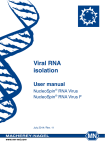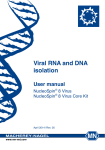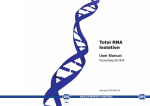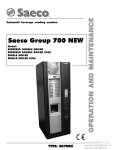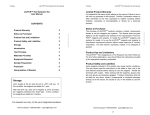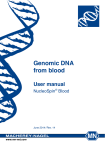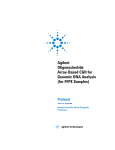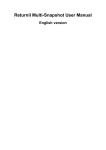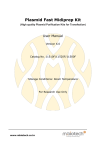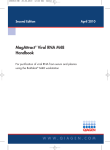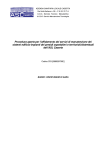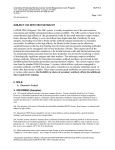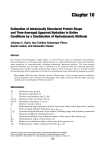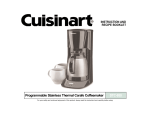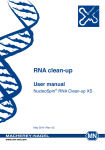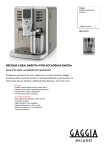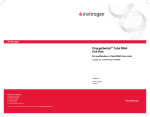Download Ribo Virus
Transcript
REF K-2/C VER 22.01.08 Ribo Virus USER MANUAL NAME Ribo Virus INTENDED USE Kit Ribo Virus is designed for the rapid preparation of highly pure viral nucleic acids (e.g. HCV, HIV, HAV, HDV, Enteroviruses, CMV, HBV*) from fluid biological samples e.g. plasma, serum, urine, bone marrow, swabs, liquor. PRINCIPLE OF ASSAY With the Ribo Virus, RNA viruses are lysed quickly and efficiently by lysis buffer RAV1 which is a highly concentrated solution of GITC. Lysis buffer and ethanol create appropriate conditions for binding of nucleic acids to the silica membrane in the Ribo Virus columns. Carrier RNA improves binding and recovery of the low-concentrated viral RNA. Contaminations (potential PCR inhibitors) like salts, metabolites and soluble macromolecular cellular components are removed in simple washing steps with ethanolic buffers RAW and finally RAV3. The nucleic acids can be eluted in low salt buffer or water and are ready-for use in subsequent reactions. The prepared nucleic acids are suitable for applications like automated fluorescent DNA sequencing, RT-PCR*, or any kind of enzymatic manipulation. The detection limit for certain viruses depends on individual detection procedures e.g. in-house nested (RT-) PCR. We highly recommend the use of internal standards as well as positive and negative controls in order to monitor the purification, amplification and detection processes. MATERIALS PROVIDED • Buffer RAV1, 35 ml; • Buffer RAW, 30 ml; • Buffer RAV3 (concentrate), 12,5 ml; • Buffer RE, 5 ml; • Carrier RNA (lyophilized), 1 mg; • Ribo Virus columns, 50; • Collecting tubes (2ml), 200; Contains reagents for 50 tests. MATERIALS REQUIRED BUT NOT PROVIDED • Biological cabinet • Ethanol (96–100%) • Microcentrifuge tubes (1.5-ml) • Sterile, RNase-free pipette tips with aerosol barrier • Disposable gloves, powderless • Microcentrifuge (with rotor for 2-ml tubes) PRODUCT USE LIMITATIONS Ribo Virus is intended as general-purpose device. No claim or representation is intended for their use to identify any specific organism or for clinical use (diagnostic, prognostic, therapeutic, or blood banking). It is rather the responsibility of the user to verify the use of the Ribo Virus kits for a specific application range as the performance characteristic of this kit has not been verified to a specific organism. *DNA viruses (e.g. HBV) are usually more difficult to isolate and require proteinase K digestion (can be ordered separately) WARNINGS AND PRECAUTIONS • • • • • • • • • • • • Components RAV1 and RAW contain guanidine thiocyanate. Guanidine thiocyanate is harmful if inhaled, or comes into contact with skin or if swallowed. Contact with acid releases toxic gas. (Xn; R: 20/21/22-36/38; S: 36/37/39). Risk Phrases R 20/21/22 Harmful by inhalation, in contact with the skin and if swallowed R 22 Harmful if swallowed R 36/38 Irritating to eyes and skin Safety Phrases S 13 Keep away from food, drink and animal feedstuffs Wear disposable gloves, laboratory coats and eye protection when handling specimens and reagents. Thoroughly wash hands afterward. Do not pipette by mouth. Do not eat, drink, smoke, apply cosmetics, or handle contact lenses in laboratory work areas. Do not use a kit after its expiration date. Dispose of all specimens and unused reagents in accordance with local regulations. Specimens should be considered potentially infectious and handled in biological cabinet in accordance with Biosafety Level 2 or other appropriate biosafety practices. Clean and disinfect all spills of specimens or reagents using a disinfectant such as 0,5% sodium hypochlorite, or other suitable disinfectant. Avoid contact of specimens and reagents with the skin, eyes and mucous membranes. If these solutions come into contact, rinse immediately with water and seek medical advice immediately. Material Safety Data Sheets (MSDS) are available on request. Use of this product should be limited to personnel trained in the techniques of DNA amplification. Workflow in the laboratory must proceed in a uni-directional manner, beginning in the Extraction Area and moving to the Amplification and Detection Area. Do not return samples, equipment and reagents in the area where you performed previous step. SPECIMEN COLLECTION AND CONSERVATION All kinds of biological fluids or semi-fluid samples can be processed e.g. serum, urine or BAL. For successful nucleic acid purification, it is important to obtain a homogeneous, clear and non-viscous sample before loading into the corresponding Ribo Virus columns. Therefore, check all samples (especially old or frozen ones) for the presence of precipitates. Avoid clearing samples by centrifugation/filtration before the RAV1lysis step, because viruses of interest may be associated with particles or aggregates. Incubation with buffer RAV1 can be prolonged in order to dissolve and digest residual cell structures, precipitates and virus particles. After collection and centrifugation, plasma (untreated or treated with anticoagulants other than heparin) or serum can be stored at 2–8°C for up to 6 hours. For long-term storage, freezing at –20°C to –80°C in aliquots is recommended. Frozen plasma or serum samples must not be thawed more than once. Repeated freezing and thawing leads to denaturation and precipitation of proteins, causing reduced viral titers and subsequently reduced yields of the isolated viral RNA. Samples containing cells, such as cerebrospinal fluid, bone marrow, urine, and most swabs, should first be filtered, or centrifuged for 10 minutes at 1500 x g and the supernatant used. STORAGE CONDITIONS AND PREPARATION OF WORKING SOLUTIONS • Ribo Virus columns should be stored dry at room temperature (15–25°C); storage at higher temperatures should be avoided. All solutions should be stored at room temperature unless otherwise stated. Ribo Virus spin columns, all buffers and reagents can be stored for up to 2 years under the above conditions without showing any reduction in performance. • Before use, add 1 ml lysis buffer RAV1 to the complete contents of the carrier RNA tube. Dissolve the RNA and transfer it back to the RAV1 bottle. Storage of carrier RNA in buffer RAV1: • Buffer RAV1 including carrier RNA can be stored at room temperature for 1-2 weeks. Storage at room temperature prevents salt precipitation and avoids prewarming the buffer solution! • Buffer RAV1 including carrier RNA can be stored at 4°C for up to 4 weeks or aliquoted and stored at –20°C for longer periods. Storage at 4°C or below may cause salt precipitation. Therefore, the mixture must be prewarmed at 40-60°C for a maximum of 5 min in order to redissolve salts. • Do not warm buffer RAV1 containing carrier RNA more than 4 times! Frequent warming, temperatures >80°C and extended heat incubation will accelerate the degradation of carrier RNA. This leads to reduced recovery of viral RNA and eventually false negative RT-PCR results, in particular if lowtiter samples are used. Before starting any Ribo Virus protocol prepare the following: • Buffer RAV3: Add 50 ml ethanol (96-100%) to buffer RAV3. Store buffer RAV3 at room temperature for up to one year. PROTOCOL Viral RNA/DNA isolation from cell-free biological fluids with Ribo Virus Before starting the viral RNA isolation, prepare a 70°C incubation block and preheat an aliquot of elution buffer/water. 1. Add 600 µl buffer RAV1 containing carrier RNA into a 1,5 ml microcentrifuge tube. Add 150 µl plasma, serum, urine, cell-culture supernatant, or cell-free body fluid to the Buffer RAV1/Carrier RNA in the microcentrifuge tube*. Mix by pulse-vortexing for 15 sec. 2. Incubate for 5 min at 70°C. * For the isolation of viral DNA add 20 µl proteinase K (20 mg/ml stock solution), to the lysis mixture (not included in this kit, but can be ordered separately). Incubation time and temperature are critical for lysis as well as RNA stability (see trouble shooting for further hints). If the resulting solution is still turbid, centrifuge the mixture for 1 min at 11,000 x g (to pellet particles, to prevent clogging of the columns). Take off the supernatant and proceed with step 2. 3. Add 600 µl ethanol (96-100%) to the sample and mix by vortexing for 15 sec. 4. Place Ribo Virus columns in 2 ml centrifuge tubes and load 700 µl lysed sample. Centrifuge for 1 min at 8,000 x g. Load the residual lysis solution onto the Ribo Virus column. Centrifuge for 1 min at 8,000 x g. The use of new 2 ml collecting tubes for every step is recommended if infectious material has to be prepared. This avoids cross-contamination and contamination of centrifuge units. Additional collecting tubes can be ordered separately. For non-infectious samples, we recommend to discard the flow-through and reuse the 2 ml tube for loading and washing steps. 5. 6. 7. 8. 9. Discard flow-through and put the Ribo Virus column into another new 2 ml collecting tube. More than two loading steps are not recommended. Add 500 µl buffer RAW to the Ribo Virus column. Centrifuge for 1 min at 8,000 x g. Discard flowthrough. Add 600 µl buffer RAV3 to the Ribo Virus column. Centrifuge for 1 min at 8,000 x g. Discard flowthrough. Place the Ribo Virus column in a new 2 ml collecting tube and add 200 µl buffer RAV3. Centrifuge for 5 min at 11,000 x g to remove ethanolic buffer RAV3 completely. Incubate the columns with open cap for 1 min at 70°C to remove any remaining traces of ethanol Place the Ribo Virus column into a new, sterile 1.5 ml centrifuge tube (not provided). Add 50 µl Buffer RE* (preheated to 70°C) and incubate for 1-2 min. Centrifuge for 1 min at 11,000 x g Viral RNA is stable for up to one year when stored at –20°C or –70°C. SHORT PROTOCOL Step Description 600 µl RAV1 1. Lyse 150 µl sample 70°C 5 min 2. Adjust DNA 3. Bind 600 µl Ethanol Load sample 1 min 8000 x g 4. Wash 1st wash: 500 µl RAW 2nd wash: 600 µl RAV3 3rd wash: 200 µl RAV3 5. Elute 1st and 2nd 1 min 8000 x g 3rd 5 min 11000 x g 50 µl Buffer RE (70°C) 1-2 min 1 min 11000 x g Sacace Biotechnologies Srl 18 San Carlo str., 81100 Caserta, Italy





